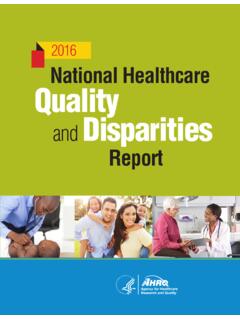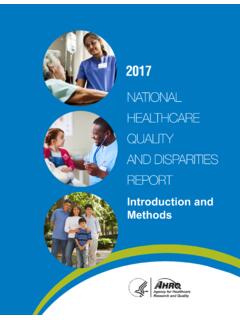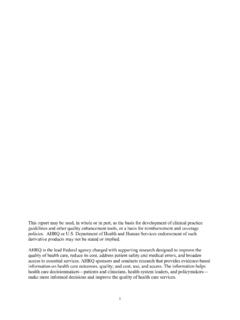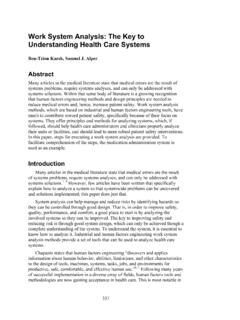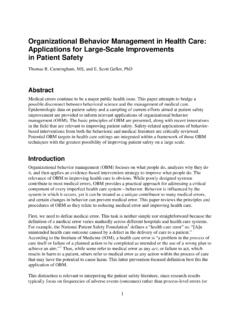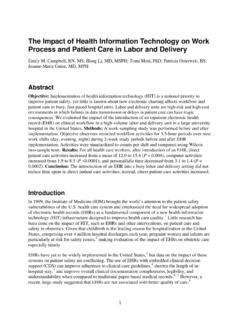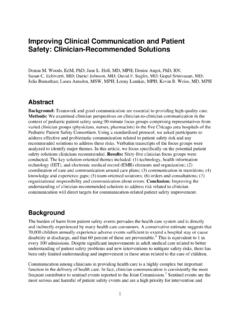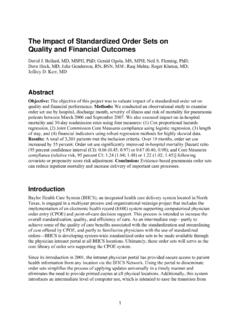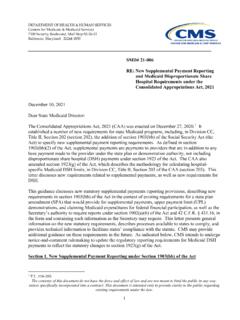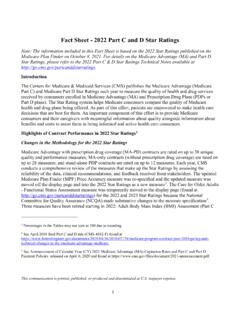Transcription of TeamSTEPPS Long-Term Care: Team Structure
1 TEAM Structure . The ratio of We's to I's is the best indicator of the development of a team. Lewis B. Ergen SUBSECTIONS. Why Teamwork? High-Performing Teams Barriers to Team Performance Multi-Team System for Patient care Team Member Characteristics TIME: 50 minutes Team TEAM Structure Structure SAY: Teamwork cannot occur in the absence of a clearly defined team. Therefore, improving upon an existing or designing a new . team Structure is the first step in implementing a teamwork system in any environment. Organizational researchers have long focused on the value of Slide teams as a unit of task work, with leadership serving as a means for improving employee performance and attitudes.
2 It is important to first understand the Structure of teams to learn how to promote MODULE. teamwork and create a climate conducive to effective team TIME: functioning. Such a climate is based on a commitment to collaboration, mutual accountability, acknowledgment, recognition, 50 minutes and professional respect. TeamSTEPPS | Team Structure 2. Team Structure OBJECTIVES. SAY: Upon completion of this module, participants will be able to: Identify the characteristics of high-performing teams. Discuss the benefits of teamwork and team Structure . Slide Describe the components and the composition of a multi-team system ( , Core Team, Coordinating Team, Contingency Team, Ancillary Services, and Administration).
3 Understand what defines a team. Define the roles and effectiveness of team members. 3 TeamSTEPPS | Team Structure Team TeamSTEPPS TEAM SKILLS Structure SAY: Team Structure is an integral part of the teamwork process. A. properly structured resident care team is an enabler and the result of effective leadership, communication, situation monitoring, and mutual support. Team Structure is the glue that holds together an effective Slide strategy for ensuring resident safety and reducing error, taking into account the knowledge, performance, skills, and attitudes of team members. TeamSTEPPS | Team Structure 4. Team Structure PARTNERING WITH THE RESIDENT. SAY: A key concept of team Structure is partnering with the resident.
4 Residents, and many times their families or significant others, are part of the resident care team. They should be embraced and valued as contributing partners to resident care . This culture change to resident-centered care is especially important in Slide nursing homes where individuals can often live for many years. For decades institutionalized care , originating from hospital KEY POINT: settings, was the customary culture. Beginning with the Omnibus reconciliation Act of 1987 (OBRA 87) and continued research, it Residents and was noted that an organization could have better outcomes by their family involving residents in their care decisions. Pressure from both members or consumers and nursing home providers caused nursing homes significant others and other Long-Term care settings to shift their focus to a more are part of the inclusive care approach, where residents are true partners in their resident care care .
5 In nursing homes across the Nation, this culture shift is team. known as resident- or person-centered care . Resident- or person-centered care in the context of the nursing home setting describes a philosophy that puts the needs, interests, and choices of residents at the center of care . It provides residents with the ability to exercise control and autonomy over their own lives, to the fullest extent possible. Evidence shows that giving residents a greater role in their care can improve their health. Ways to effectively involve residents in their own care are to actively enlist the resident s (and family members ) participation in unit-based rounds, care planning, and key committees.
6 Continued . 5 TeamSTEPPS | Team Structure Team Structure PARTNERING WITH THE RESIDENT. SAY: Learning to work with residents and families as true partners is neither easy nor intuitive. Learn to listen. Ask residents how involved they prefer to be in their own Slide care this includes medical decisions as well as lifestyle choices ( , what activities they prefer to attend, when and how they prefer to bathe, what time they would like to go to KEY POINT: sleep and rise). Residents and Explain things to residents and their families in language they their family will understand . Speaking in lay terms can prevent any members or inadvertent embarrassment or confusion. significant others are part of the Ask residents about their concerns before any details are resident care provided.
7 This can help ensure residents will be active listeners team. and understand what is being said to them. Remind residents and families that they have access to relevant information ( , their medical record). Continuously ask residents and their families for feedback and to be proactive participants in their care and life at the nursing home. DISCUSSION (Optional): Residents, families, and other visitors may have questions and concerns from time to time. Understanding the complexity of nursing home staffing can be confusing to residents, families, and visitors. Consider directing residents, families, and visitors to the appropriate staff person or agency to alleviate their concerns and have their questions answered.
8 A posting or brochure of the nursing home s hierarchy (organizational Structure ) and names of department contacts can be a useful and appreciated tool to residents and their families. Does your nursing home have a process to communicate resident/family concerns? How is it communicated? How often? How well is the process working? 6 TeamSTEPPS | Team Structure Team WHY TEAMWORK? Structure SAY: The goals of teamwork are to: Reduce clinical errors. Improve resident outcomes. Improve process outcomes. Slide Improve resident satisfaction. Increase family satisfaction. Increase staff satisfaction. Reduce staff turnover. Reduce resident and family grievances and complaints.
9 Teamwork may be determined by the physical or organizational Structure of facilities. Teams may include those assigned to work in that area ( , neighborhoods, secured units, floors) but are not limited to only the individuals who work in a particular department. Individuals from several departments may work together on a team. DISCUSSION: What are some other benefits of teamwork? TeamSTEPPS | Team Structure 7. Team Structure HIGH-PERFORMING TEAMS. SAY: Over the course of this training, we will touch on the many interrelated aspects of high-performing teams. Generally speaking, high-performing teams have some common traits. Slide DISCUSSION: In what way do Shared Mental Models contribute to the success of high-performing teams?
10 Answers include: members can anticipate each other s needs;. coordinate without the need to communicate overtly; know when explicit communication is best; and know where to look for expertise. SAY: Other traits of high-performing teams, which we will explore in more detail later in this course, include: Have clear roles and responsibilities. Have a clear, valued, and shared vision ) A common purpose An engaging purpose A leader who promotes the vision with the appropriate level of detail Optimize resources. Have strong team leadership. Engage in a regular discipline of feedback Regularly provide feedback to each other and as a team Establish and revise team goals and plans Differentiate between higher and lower priorities Have mechanisms for anticipating and reviewing issues of team members Periodically diagnose team effectiveness, including its results, processes, and vitality (including morale, energy, and retention Continued.
